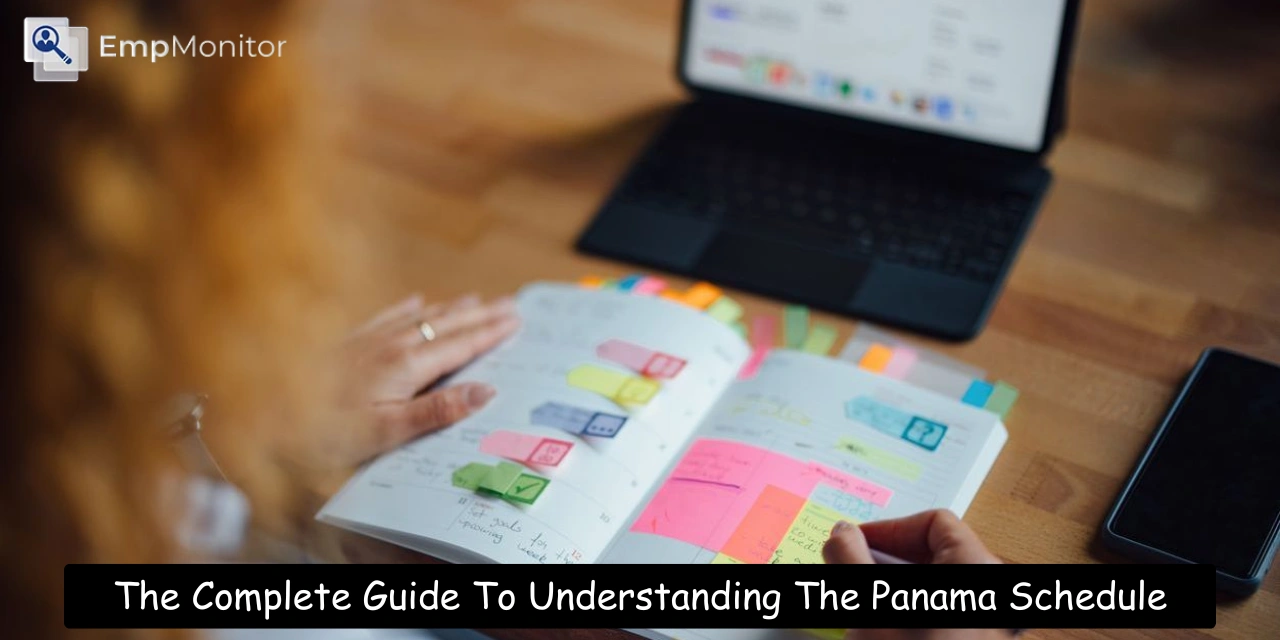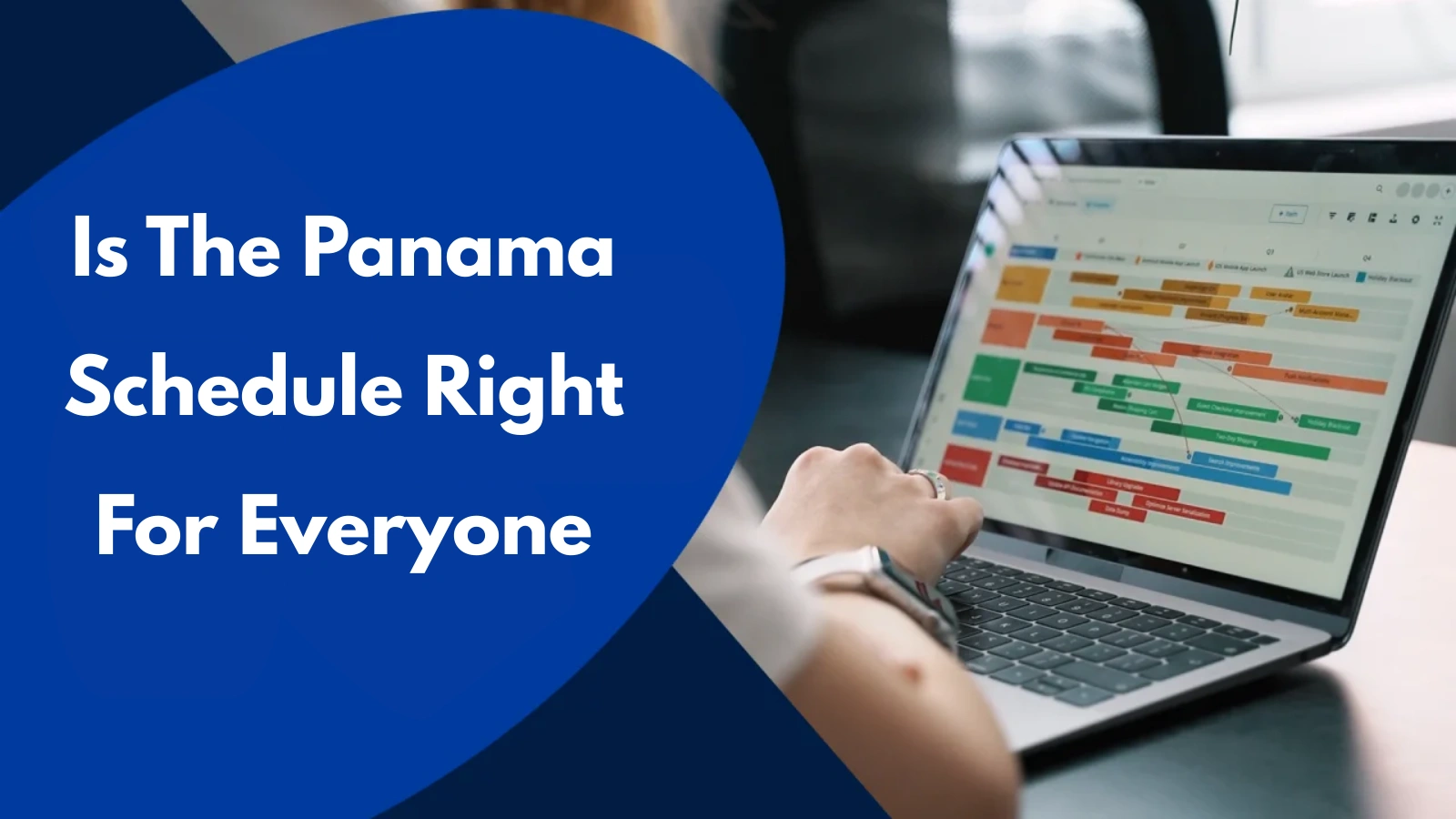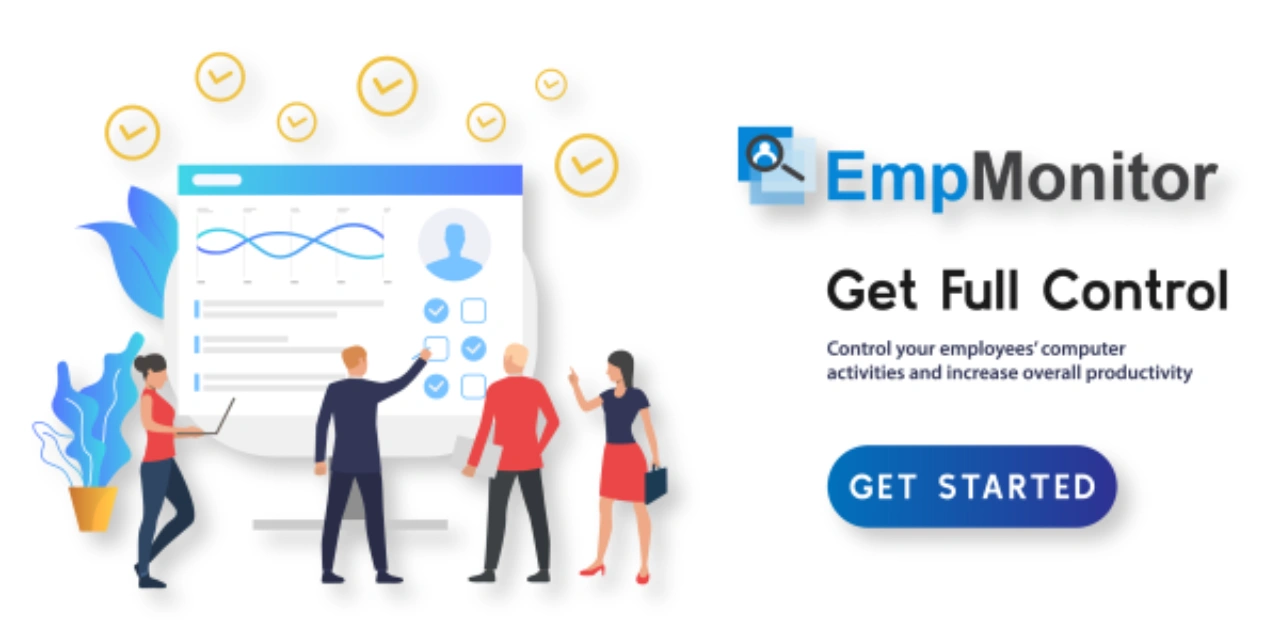Work schedules are the backbone of any organization that runs around the clock. From hospitals to manufacturing plants and even customer service centers, shift planning determines productivity, employee satisfaction, and overall balance. Among the many shift patterns, the panama schedule has gained immense popularity for its unique approach to work-life balance.
This guide explores everything you need to know about the panama schedule, including its structure, benefits, challenges, and real-world examples. Whether you are an employee, manager, or HR professional, this comprehensive overview will help you understand why this schedule is widely used and how it can benefit both organizations and their teams.
Listen To The Podcast Now!
What Is A Panama Schedule?
The Panama schedule is a rotating shift pattern that typically spans 14 days, where employees alternate between working and off days in a structured manner. It is widely used in industries that require continuous operations, such as emergency services, utilities, healthcare, and security.
The system balances work and rest days, ensuring employees don’t get burned out while still maintaining coverage for 24/7 operations. Unlike traditional 9-to-5 jobs, this shift pattern adapts to industries where non-stop service is critical.
Why Panama Schedule Got Created?
This shift schedule originated as a solution for industries that required uninterrupted staffing. Standard shift patterns often led to fatigue, lower productivity, and high employee turnover.
The rotating nature of this schedule aimed to:
- Distribute shifts evenly among employees.
- Provide extended time off between workdays.
- Ensure consistent coverage without overburdening staff.
- Allow employees to plan personal activities with predictable breaks.
Over the years, it has become one of the most reliable approaches to maintaining efficiency while caring for employee well-being.
Also Read:
Shift Schedules: How To Create, Types, & Advantages In 2025
How Panama Schedule Work?
This shift system typically divides employees into teams. Each team rotates through a repeating cycle of workdays and off days over a two-week period.
The most common version includes:
- 2 days of work
- 2 days off
- 3 days of work
- 2 days off
- 2 days of work
- 3 days off
This repeating cycle covers 24/7 operations, ensuring staff is always available without overwhelming individuals. Because of its structured format, employees can predict their time off well in advance.
Is The Panama Schedule The Same As A 2-2-3 Schedule?
Many people wonder if this rotation schedule is the same as a 2-2-3 system. The answer is yes—the two are often used interchangeably. If you’re asking what is a 2 2 3 schedule, it essentially means two days of work, followed by two days off, then three days of work. The cycle then reverses, ensuring fairness and balance.
This type of rotating shifts schedule is popular in industries like healthcare and manufacturing because it provides consistent coverage while allowing employees regular rest periods.
So, how does a 2-2-3 schedule work? It follows the same principle, making sure no one works too many consecutive days while still meeting operational needs. One of the biggest advantages of the 2-2-3 or Panama schedule is that it reduces burnout by giving employees frequent days off, while still maintaining operational efficiency. It also makes planning personal activities easier, as workers can anticipate their off-days in advance, improving overall morale and productivity.
What Does A Panama Schedule Look Like?
To better understand how the Panama schedule looks in practice, let’s look at a Panama schedule example for a two-week cycle:
Week 1
- Monday: Work
- Tuesday: Work
- Wednesday: Off
- Thursday: Off
- Friday: Work
- Saturday: Work
- Sunday: Work
Week 2
- Monday: Off
- Tuesday: Off
- Wednesday: Work
- Thursday: Work
- Friday: Off
- Saturday: Off
- Sunday: Off
This cycle then repeats, giving employees both long weekends and balanced workdays.
Also Read:
What Are Rotating Shifts: Pros, Cons, And Best Tips
What Are The Benefits Of Using This Work Schedule?
This schedule comes with several advantages for both employees and employers, making it a popular choice in industries that require continuous coverage. It’s also often considered a part of modern flexible work schedules, giving teams more control over their time while maintaining operational consistency.
Predictable Work-Life Balance:
Unlike erratic shifts, this system provides a consistent rhythm. Employees can plan personal commitments, vacations, or family activities months in advance, reducing stress and improving overall satisfaction.
Reduced Fatigue:
By interspersing regular rest days between work periods, employees experience less burnout and maintain higher energy levels throughout their shifts.
Fair Distribution of Shifts:
The rotation ensures that no one feels overburdened. Everyone receives an equitable share of day, night, and weekend shifts, promoting a sense of fairness and team harmony.
Boosted Productivity:
Well-rested employees can focus better, make fewer mistakes, and perform tasks more efficiently, benefiting overall operational outcomes.
Extended Breaks and Long Weekends:
With longer consecutive days off, workers enjoy extended breaks, which supports mental health, encourages recreation, and increases overall job satisfaction.
Also Read:
The Complete Guide To Flexible Work Schedules
What Challenges Do Employees Face On A Panama Schedule?
While this shift system offers many benefits, such as predictable workdays and extended weekends, it also comes with challenges that employees and employers must address to maintain productivity and well-being.
How Do Night Shifts Affect Employees?
This rotation schedule requires 24/7 coverage, which means many employees will have to work overnight or late-night shifts. Night work can affect the natural circadian rhythm, leading to fatigue, reduced concentration, and decreased overall performance.
Why Are Inconsistent Sleep Patterns a Concern?
Rotating between day and night shifts can disrupt sleep cycles. Irregular sleep not only impacts physical and mental health but also reduces productivity during working hours. Employees may struggle with alertness, making proper monitoring essential.
How Does the Schedule Impact Social Life?
Even though the schedule provides extended weekends, employees might find it difficult to coordinate social events, family gatherings, or personal activities on workdays. Balancing personal and professional life can become a challenge without proper planning and support.
What About the Adjustment Period?
New employees often face difficulties adapting to alternating work and rest days. It takes time to get used to the rhythm of this rotation schedule, and without oversight, productivity might drop during the adjustment phase.
How Can Managers Ensure Productivity on a Panama Schedule?
One of the biggest challenges of implementing a panama schedule is maintaining accountability and performance during rotating shifts. This is where tools like EmpMonitor come in.
EmpMonitor seamlessly empowers employee management operations, providing detailed insights into daily and hourly activities, attendance, workflow patterns, and overall productivity. By leveraging such software, businesses can:
- Monitor employees effectively without micromanaging.
- Identify patterns of productivity and idle time.
- Support employees in staying on track across day and night shifts.
- Minimize errors and ensure smooth operations throughout the rotating schedule.
How Can EmpMonitor Improve Panama Schedule Management?
Implementing a panama schedule successfully requires tools that enhance oversight and productivity. EmpMonitor is an employee monitoring software that goes beyond simple tracking to provide actionable insights that help both managers and employees thrive.
Key Features of EmpMonitor for Panama Schedule Efficiency
1. Real-Time Activity Tracking:
With rotating shifts and variable work hours, it can be difficult to know what employees are working on at any given moment. EmpMonitor’s real-time activity tracking allows managers to view live application use, website visits, and productivity from a unified dashboard. This ensures accountability and helps identify opportunities to optimize workflow.
2. Time Tracking for Shift Productivity:
Switching between day and night shifts can make it hard to measure actual work hours. EmpMonitor’s time-tracking tools provide detailed insights into productive and idle hours, automatically generating timesheets. This feature ensures employees are recognized for their contributions and helps managers assess performance accurately.
3. Attendance Monitoring:
Maintaining attendance records for a rotating schedule can be challenging. EmpMonitor’s attendance monitoring module tracks login and logout times, manual attendance, and leave records. This ensures accurate reporting and simplifies HR processes while keeping operations running smoothly.
4. Live Screencasting and Screen Recording:
For industries where support and oversight are crucial, live screencasting allows managers to view employee screens in real time without disturbing their work.
Combined with screen recording, this feature helps resolve issues, verify compliance, and provide training opportunities, all essential for teams working under this shift system.
By incorporating EmpMonitor into a Panama schedule, organizations can ensure fair workload distribution, maximize productivity, and provide employees with the tools and support they need to succeed, even in rotating shifts.
How Does The Panama Schedule Compare With Other Shift Systems?
To fully understand the advantages of this rotation schedule, it’s useful to compare it with other common shift patterns.
Panama Schedule vs 4-on-4-off:
The 4-on-4-off schedule requires employees to work four consecutive days followed by four days off. While straightforward, it can lead to fatigue due to long stretches of work without sufficient breaks.
In contrast, this work rotation uses shorter cycles, reducing exhaustion while still maintaining adequate coverage.
Panama Schedule vs 5-2 Schedule:
The traditional 5-2 schedule (Monday to Friday work, Saturday-Sunday off) works well in typical office environments. However, it fails to meet the needs of industries that require round-the-clock staffing, such as healthcare, manufacturing, or emergency services.
This rotation schedule provides continuous coverage without overburdening employees.
Panama Schedule vs 12-Hour Rotating Shifts:
Some companies implement 12-hour rotating shifts to ensure coverage throughout the week. While this provides flexibility, it often leads to extreme fatigue and disrupts work-life balance.
This shift system mitigates this by offering regular rest days, creating a more sustainable and balanced workflow for employees.
This comparison highlights why many organizations favor this rotation schedule: it strikes a balance between operational efficiency and employee well-being, making it a practical choice across various industries.
Tips For Employees Working On A Panama Schedule
For employees, successfully adapting to this shift system requires strategy and discipline.
- Prioritize Sleep: Stick to a routine, even on days off, to avoid sleep disruptions.
- Stay Active: Exercise can help regulate your body clock and maintain energy.
- Meal Planning: Eat balanced meals to fuel your body for varying shifts.
- Communicate With Family: Inform loved ones about your schedule to avoid conflicts.
- Use Days Off Wisely: Plan rest and leisure activities to make the most of long weekends.
Tips For Employers Using The Panama Schedule
Employers can maximize the effectiveness of this shift system by following best practices.
- Provide Clear Training: Help employees understand the schedule and how to adapt.
- Encourage Team Collaboration: Balanced teamwork reduces the pressure of rotating shifts.
- Monitor Health: Offer wellness programs to help staff cope with rotating shifts.
- Use Scheduling Software: Automating the schedule avoids confusion and errors.
- Collect Feedback: Regular employee feedback ensures continuous improvement.
What Are The Advantages Of This Schedule For Employers?
his shift system not only benefits employees but also provides several key advantages for organizations:
Higher Retention Rates:
Predictable work and rest patterns increase job satisfaction, making employees less likely to leave. This reduces turnover costs and helps maintain experienced staff.
Improved Attendance:
With regular rest days, employees experience less burnout, leading to fewer missed shifts and more reliable staffing.
Operational Efficiency:
Consistent coverage ensures that business operations run smoothly. Managers can plan projects and workloads more effectively without sudden staffing gaps.
Enhanced Safety:
Well-rested employees are less prone to errors and accidents, which is particularly important in high-risk industries such as manufacturing, healthcare, and logistics.
Overall, this scheduling system creates a win-win situation by supporting employee well-being while improving business performance.
Is The Panama Schedule Right For Everyone?
This shift system may not suit every worker. Night shifts, in particular, can be challenging for individuals who struggle with irregular sleep. Parents with young children or those who prefer strict daily routines may find it difficult to adapt.
However, for employees who value extended weekends and flexible time off, this schedule often feels rewarding.
Conclusion
The panama schedule stands out as one of the most balanced approaches to managing shift work. It combines predictability, fairness, and efficiency while ensuring continuous operations.
For industries that cannot stop running, it offers a practical solution to workforce management. Employees benefit from extended breaks and predictable cycles, while employers enjoy higher productivity and reduced turnover.
As organizations evolve, the panama schedule will continue to remain a cornerstone of 24/7 workforce management. To make the most of this scheduling system, tools like EmpMonitor can help managers track productivity, monitor attendance, and support employees in maintaining high performance across rotating shifts, ensuring both operational efficiency and employee satisfaction.
FAQs
1. Can the Panama Schedule be customized for different team sizes?
Ans. Yes, the Panama Schedule is highly flexible and can be adapted to suit small teams or large departments, ensuring fair rotation and coverage for all employees.
2. How does this work cycle handle public holidays or special events?
Ans. Employers can adjust the rotation to accommodate holidays or special events, allowing employees to take time off without disrupting continuous operations.
3. Is this rotation schedule suitable for remote or hybrid teams?
Ans. Absolutely. With proper planning and digital scheduling tools, remote and hybrid teams can follow this rotation schedule while maintaining productivity and accountability.
















